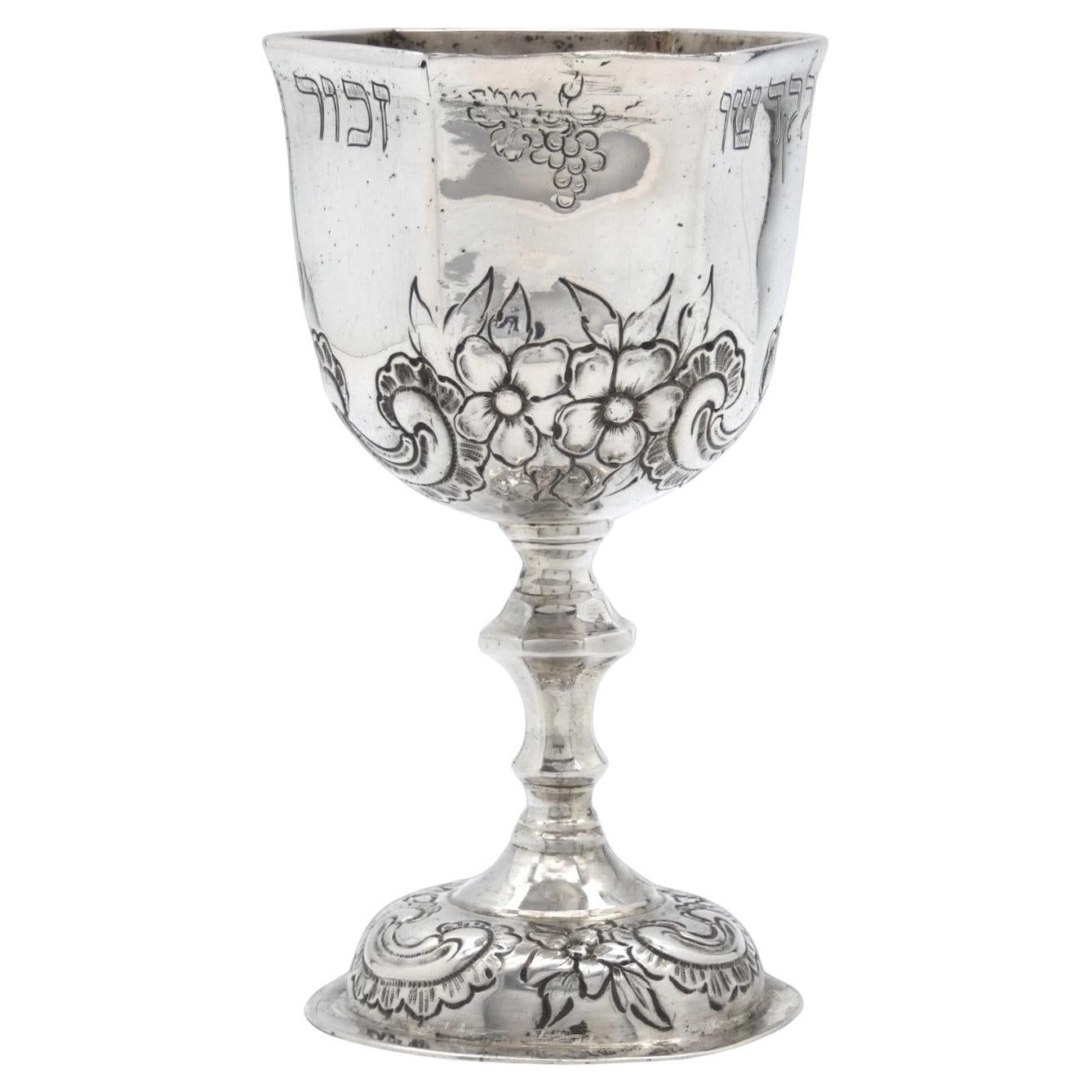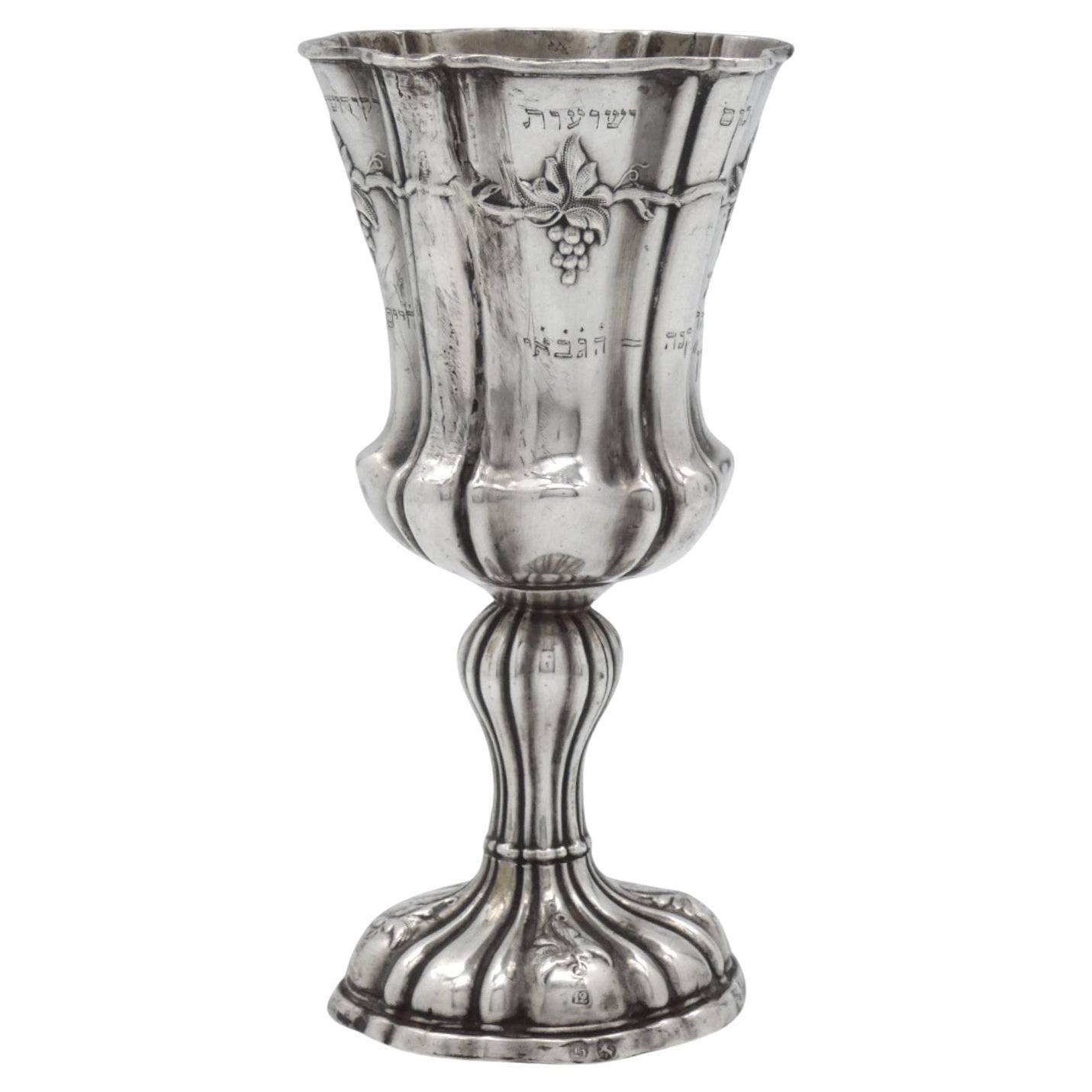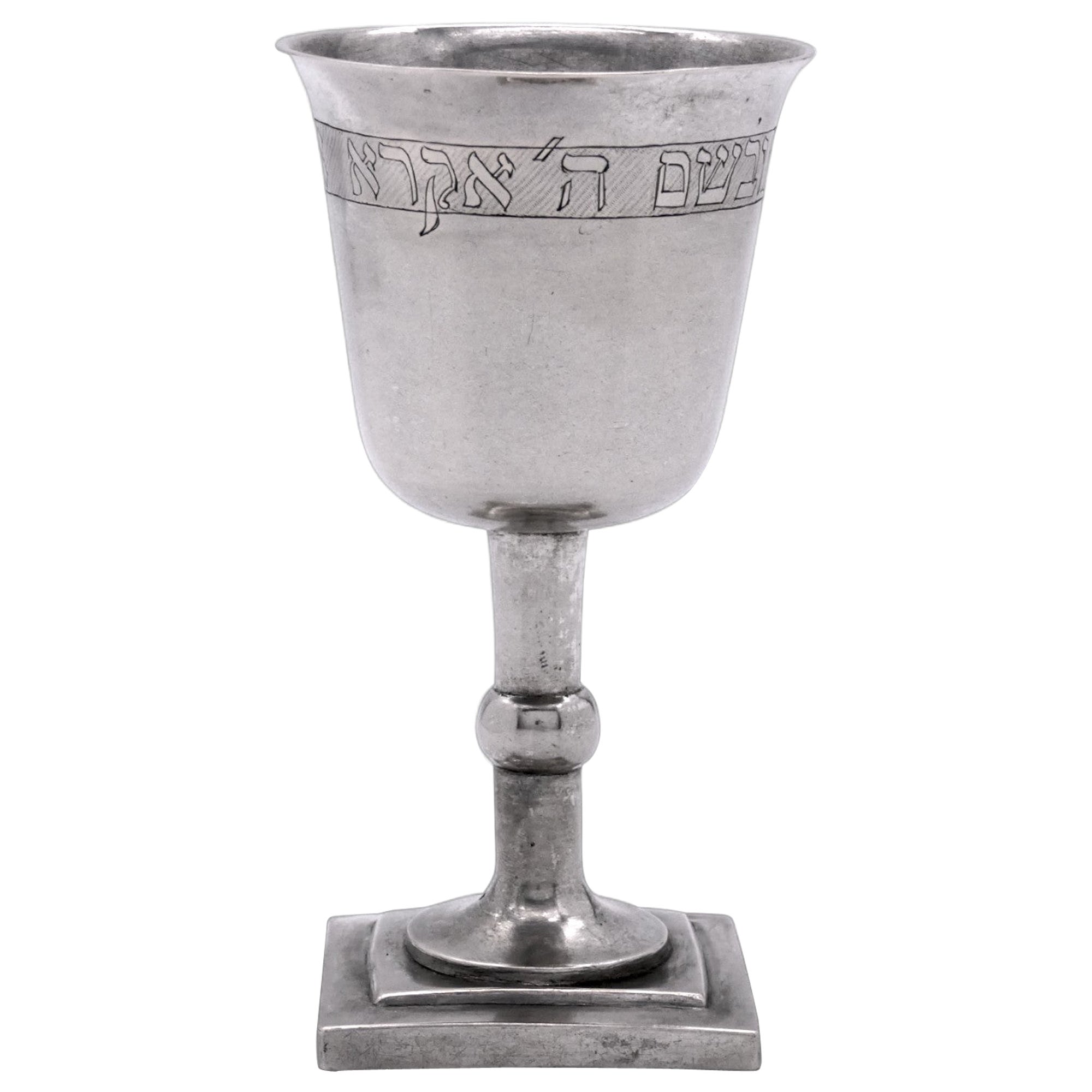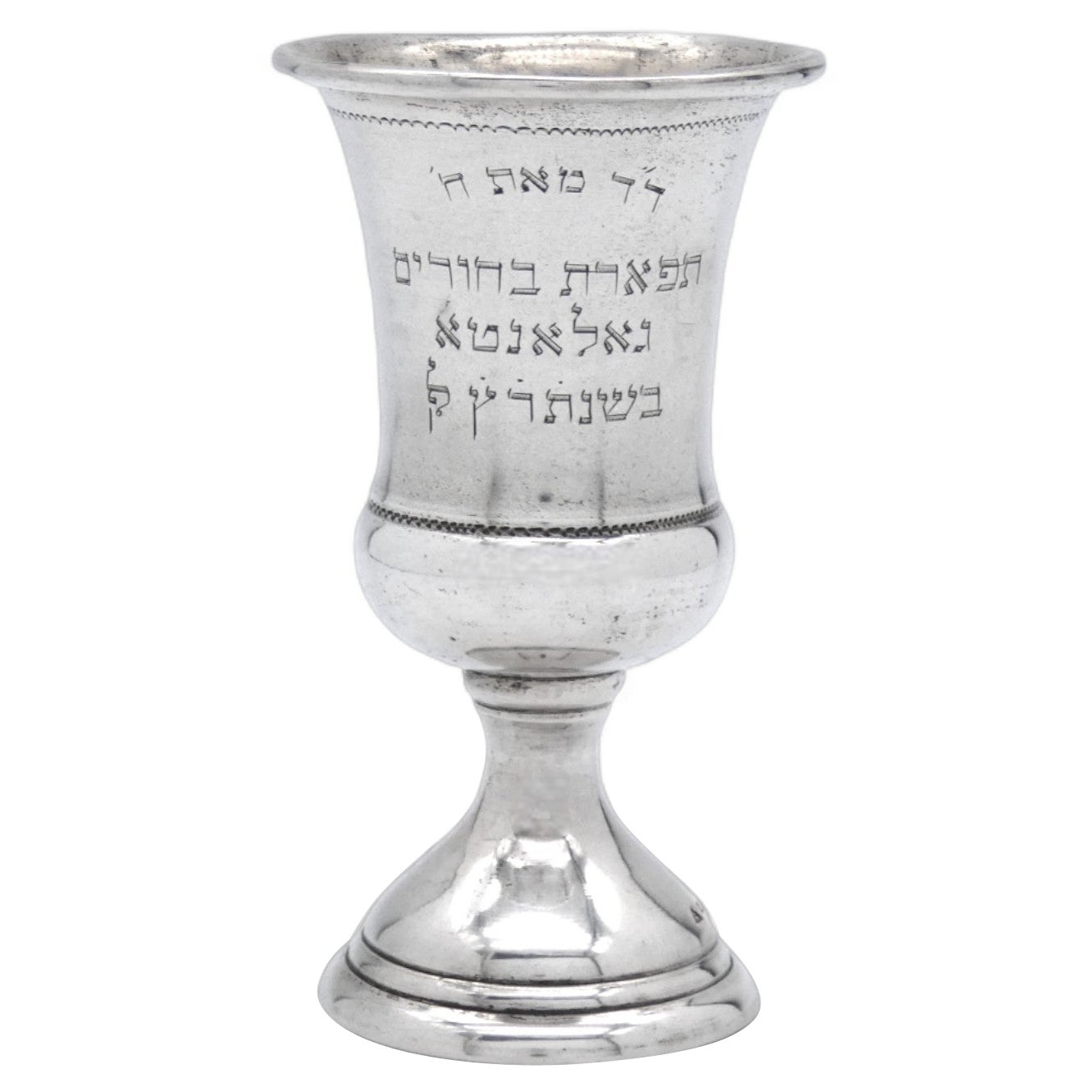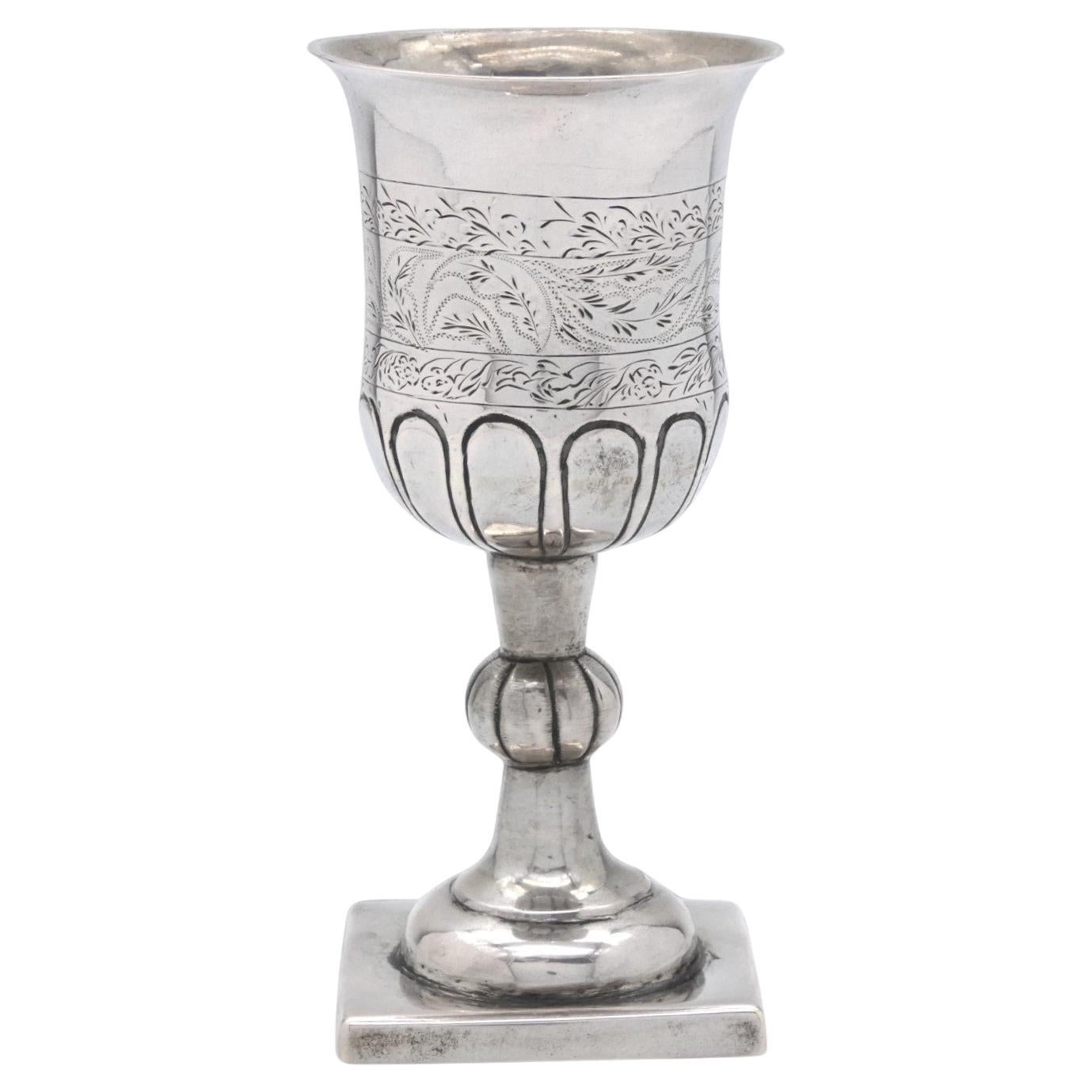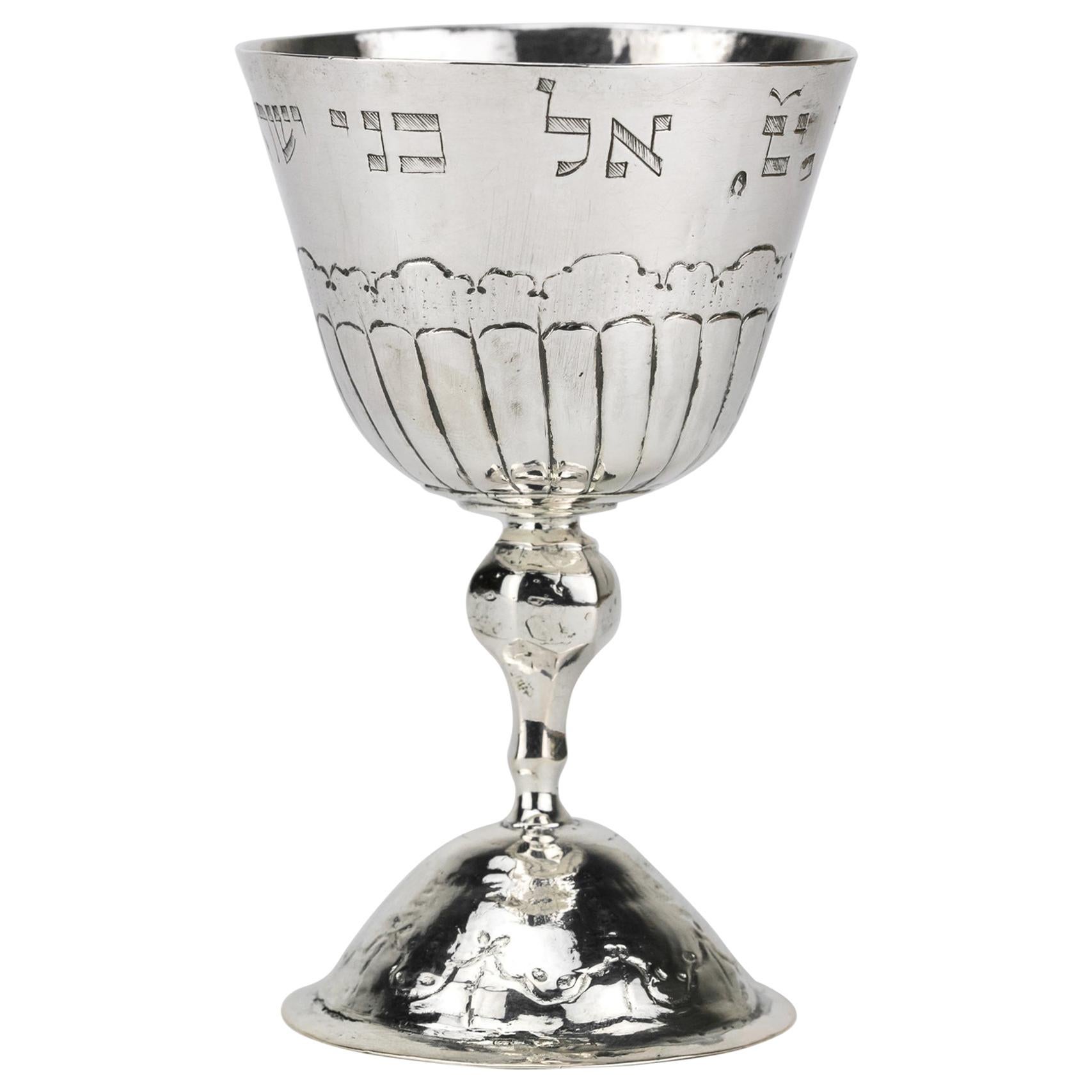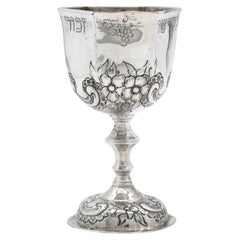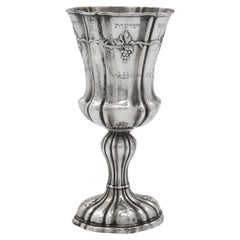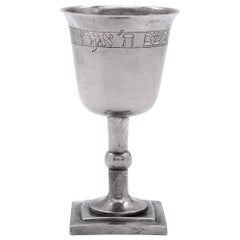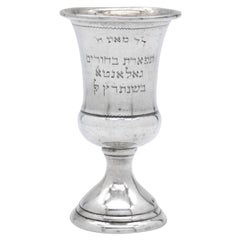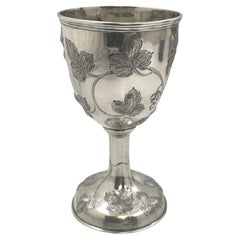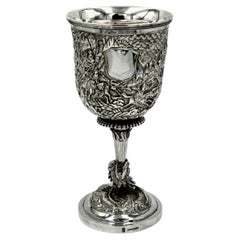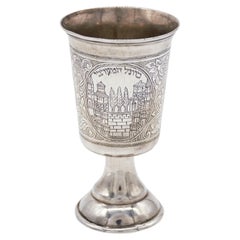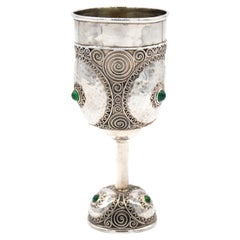Items Similar to A Silver Kiddush Goblet, Germany 18th Century
Want more images or videos?
Request additional images or videos from the seller
1 of 9
A Silver Kiddush Goblet, Germany 18th Century
$5,200
$6,50020% Off
£3,921.32
£4,901.6520% Off
€4,535.19
€5,668.9920% Off
CA$7,295.57
CA$9,119.4720% Off
A$8,109.48
A$10,136.8520% Off
CHF 4,250.82
CHF 5,313.5220% Off
MX$99,036.39
MX$123,795.4920% Off
NOK 53,068.99
NOK 66,336.2420% Off
SEK 49,928.02
SEK 62,410.0320% Off
DKK 33,849.34
DKK 42,311.6820% Off
About the Item
An Important Silver Kiddush Goblet made in Germany in the 18th Century.
Goblet rests on a circular domed base with floral scrolling encircling the base.
Knopped trophy stem supports the main body which has gadroon-style repousse scrolling surrounding the lower half.
The goblet has a flared upper lip under which there is an engraved biblical verse written in Hebrew translated to "Moshe conveyed the holidays given by G-d to the tribes of Israel".
Hallmarked on the upper half of the main body.
- Dimensions:Height: 4.34 in (11 cm)Width: 2.56 in (6.5 cm)Depth: 2.56 in (6.5 cm)
- Materials and Techniques:
- Place of Origin:
- Period:
- Date of Manufacture:18th century
- Condition:Wear consistent with age and use.
- Seller Location:New York, NY
- Reference Number:1stDibs: LU5281239832072
About the Seller
5.0
Recognized Seller
These prestigious sellers are industry leaders and represent the highest echelon for item quality and design.
Established in 2006
1stDibs seller since 2020
134 sales on 1stDibs
Typical response time: 8 hours
- ShippingRetrieving quote...Shipping from: Pomona, NY
- Return Policy
Authenticity Guarantee
In the unlikely event there’s an issue with an item’s authenticity, contact us within 1 year for a full refund. DetailsMoney-Back Guarantee
If your item is not as described, is damaged in transit, or does not arrive, contact us within 7 days for a full refund. Details24-Hour Cancellation
You have a 24-hour grace period in which to reconsider your purchase, with no questions asked.Vetted Professional Sellers
Our world-class sellers must adhere to strict standards for service and quality, maintaining the integrity of our listings.Price-Match Guarantee
If you find that a seller listed the same item for a lower price elsewhere, we’ll match it.Trusted Global Delivery
Our best-in-class carrier network provides specialized shipping options worldwide, including custom delivery.More From This Seller
View AllA Silver Kiddush Goblet, Germany 19th Century
Located in New York, NY
A Lovely Silver Kiddush Goblet made in Germany in the 19th Century
Kiddush Goblets such as these were fairly common in many households in Germany during the 19th century.
Kiddush G...
Category
Antique 19th Century German Sterling Silver
Materials
Silver
$1,600 Sale Price
54% Off
A Silver Kiddush Goblet, Austria Circa 1860
Located in New York, NY
A Fancy Silver Kiddush Goblet, made in Austria Circa 1860.
Kiddush Goblet is uniquely designed as this kiddush has no distinct shape and has distinctive ridges running across the le...
Category
Antique Mid-19th Century Austrian Sterling Silver
Materials
Silver
$4,800 Sale Price
20% Off
A Silver Kiddush Goblet, Poland mid 19th Century
Located in New York, NY
A Refined Silver Kiddush Goblet, made in Poland in the mid-19th Century.
This Polish Kiddush Goblet has an interesting feature about it. On the upper body, there is a Hebrew verse e...
Category
Antique Mid-19th Century Polish Sterling Silver
Materials
Silver
$4,000 Sale Price
20% Off
A Silver Kiddush Goblet, Hungary Circa 1930
Located in New York, NY
A Dedicated Silver Kiddush Goblet, made in Hungary Circa 1930.
Seemingly this Kiddush Goblet was donated pre-WWll by a youth group in Galanta which at that time was part
of Hungary...
Category
Early 20th Century Hungarian Sterling Silver
Materials
Silver
$2,800 Sale Price
20% Off
A Silver Kiddush Goblet, Poland mid 19th Century
Located in New York, NY
A Dignified Silver Kiddush Goblet, made in Poland in the mid-19th Century.
This Polish goblet is one of the most commonly used silver Kiddush Goblets in the Polish, Ukrainian, and G...
Category
Antique Mid-19th Century Polish Sterling Silver
Materials
Silver
$2,000 Sale Price
42% Off
18th Century German Silver Festival Kiddush Goblet
Located in New York, NY
Silver Kiddush Goblet, Hieronymus Mittnacht, Augsburg, Germany, 1763-1765.
Classic style tulip-form bowl with chased scalloped design motif with facete...
Category
Antique 1760s German Religious Items
Materials
Silver
$6,800 Sale Price
20% Off
You May Also Like
Eben Cutler Coin Silver Goblet/ Kiddush Cup from 19th Century
Located in New York, NY
Eben Cutler, coin silver goblet from the 19th century adorned with vine-like motifs, faintly gilt inside. It measures 6 1/8'' in height by 3 1/2'' i...
Category
Antique 19th Century American Sterling Silver
Materials
Silver
Chinese Export Silver Goblet
Located in London, GB
A rare Chinese Export Silver Goblet depicting the story of the Three Kingdoms. The goblet embossed and chased with characters of army of General Dian Wei (典韦) and General Lü Bu (吕布)....
Category
Antique 1870s Chinese Chinese Export Sterling Silver
Materials
Silver
$10,347
Rare "Safed" kiddush cup, late 19th century Poland/ Eretz ISRAEL
Located in Tel Aviv - Jaffa, IL
This 84 silver cup was made in Europe, in Poland or parts of Poland that are in modern Russia in the 19th century, the interesting and important in this cup types is that they were s...
Category
Antique 1890s Israeli Sterling Silver
Materials
Silver
Important Early 20th Century Silver Kiddush Goblet by Bezalel School Jerusalem
Located in Tel Aviv - Jaffa, IL
Important Handmade sterling silver Kiddush goblet by Bezalel School, Jerusalem, circa 1910-1913.
On round base decorated with silver filigree and Cabouchon shaped green agate applications.
The base fitted with Bezalel mark. The upper portion is all adorned with amazing filigree work, the base and the actual cup adorned with swirling filigree designs, in the middle there are 3 roundels, made in another technique of hammered silver, similar to the works that were produced in this time all over Europe, in the middle of each roundel there is a perfectly centered Cabouchon green agate.
This work is attributed to Yehia Yemini.
The goblet is marked on the base, with the earliest silver mark of the school that just say "Bezalel" in Hebrew.
Yehia Yemini :
Was one of the biggest and must famous Bezalel silver...
Category
Early 20th Century Israeli Jugendstil Sterling Silver
Materials
Silver
Antique Portuguese Goblet Cup solid 833 Silver / 173 gr
Located in SE
Antique Portuguese Silver Cup, thick walled, with continuous cast floral ornaments and well preserved internal gilding.
This cup has a set of small sized conventional Portuguese ha...
Category
Vintage 1920s Portuguese Renaissance Revival Barware
Materials
Gold Plate, Silver
19th Century Chinese Export Solid Silver Goblet, Leeching, c.1870
By Leeching
Located in Royal Tunbridge Wells, Kent
Antique 19th Century Chinese export solid silver goblet, a testament to its impressive size and exceptional craftsmanship. The goblet, a marvel of fine quality, boasts a single-walle...
Category
Antique 19th Century Chinese Chinese Export Barware
Materials
Silver
More Ways To Browse
Kiddush Goblet
Sterling Trophy Engraved
Antique German Repousse Sterling
Trophy Goblet
Vintage Place Card Holders
Eaton Antique Furniture
Georgian Sterling Salver
Gorham Art Deco
Kiddush Goblet
Sheffield England Silver Serving Spoon
Tiffany Blue Book Catalog
Used Kitchen Glasgow
Victorian Sterling Silver Goblet
19th Century Sterling Silver Cutlery
Antique Coffee Servers
Antique Glass Butter Dish
Antique Potato
Art Deco Tea Spoons
